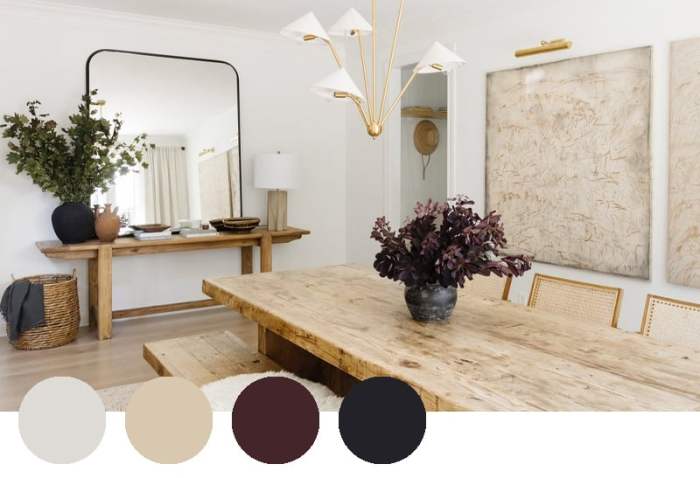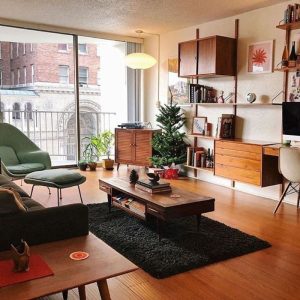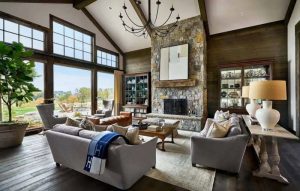
Neutral color palettes have become a mainstay in interior design, offering a timeless and versatile approach to creating inviting and stylish living spaces. They provide a sense of calm and tranquility, allowing for a sense of spaciousness and serving as a blank canvas for your personal style to shine.
From the cool elegance of grays to the warm embrace of beiges, neutral colors offer a range of options to suit diverse tastes and design aesthetics. Whether you’re seeking a minimalist haven or a cozy retreat, exploring the possibilities of neutral palettes can unlock a world of design inspiration.
Understanding Neutral Color Palettes

Neutral color palettes are a foundational element in interior design, offering a canvas for expressing personal style and creating harmonious living spaces. They encompass a range of colors that are considered to be non-chromatic, meaning they lack a strong hue and instead rely on variations in lightness and darkness. These colors are often described as calming and versatile, providing a backdrop for bolder accents and furniture pieces.
Psychological Impact of Neutral Colors
Neutral colors exert a profound influence on the atmosphere of a living space, impacting our mood, perception, and overall well-being. They are often associated with feelings of serenity, tranquility, and spaciousness. Their calming nature can promote relaxation and reduce stress, making them ideal for creating a soothing and inviting ambiance.
Common Neutral Colors in Interior Design
Neutral colors are diverse and offer a wide range of possibilities for interior design. Here are some of the most commonly used neutral colors:
- White: White is the epitome of neutrality, symbolizing purity, cleanliness, and simplicity. It reflects light, making spaces feel larger and brighter. It provides a blank canvas for introducing pops of color and textures.
- Gray: Gray is a versatile neutral that can range from cool and sophisticated to warm and inviting. It can be used to create a sense of calm and understated elegance.
- Beige: Beige is a warm and earthy neutral that evokes feelings of comfort and familiarity. It pairs well with natural materials and creates a cozy and inviting atmosphere.
- Black: Black is a powerful neutral that adds depth, sophistication, and drama to a space. It can be used as an accent color or to create a bold and modern aesthetic.
- Brown: Brown is a grounding neutral that brings a sense of warmth and stability to a space. It is often associated with nature and can be used to create a rustic or traditional feel.
Benefits of Using Neutral Color Palettes
Neutral color palettes are a popular choice for living spaces due to their versatility and ability to create a sense of calm and sophistication. Neutral colors are often associated with a sense of peace and tranquility, making them ideal for creating a relaxing and inviting atmosphere.
Creating a Sense of Calm and Spaciousness
Neutral colors can make a room feel larger and more spacious, especially when used on walls and ceilings. This is because they tend to recede visually, creating a sense of depth and openness. Additionally, neutral colors can help to minimize distractions and create a sense of calm, making them ideal for spaces where relaxation and peace are desired.
Neutral Color Palette Ideas for Living Spaces
Neutral color palettes offer a timeless and versatile foundation for living spaces, providing a sense of calm and sophistication. They serve as a blank canvas for personal expression, allowing you to incorporate pops of color through furniture, artwork, and accessories.
Modern Living Room with Shades of Gray and White
A modern living room embraces clean lines, minimalist aesthetics, and a focus on functionality. A neutral color palette using shades of gray and white creates a sophisticated and calming atmosphere.
- Base Color: White acts as the base color, providing a bright and airy backdrop for the space. Choose a crisp white for walls, trim, and ceilings to create a sense of openness and spaciousness.
- Accent Color: Introduce different shades of gray as accent colors, creating visual interest and depth. Use a light gray for furniture upholstery, a medium gray for throw pillows and rugs, and a darker gray for accent walls or artwork.
- Metallic Accents: Incorporate metallic accents like silver or chrome in lighting fixtures, coffee tables, or decorative elements to add a touch of modern sophistication.
Minimalist Living Room with a Limited Color Range
Minimalism emphasizes simplicity and functionality, focusing on essential elements and clean lines. A neutral color palette with a limited color range enhances this aesthetic.
- Base Color: White serves as the dominant color, providing a clean and uncluttered backdrop for the space.
- Accent Color: Introduce a single accent color, such as a soft gray or a muted beige, for furniture upholstery, rugs, or throw pillows. This creates a subtle contrast without overwhelming the minimalist aesthetic.
- Natural Materials: Incorporate natural materials like wood, stone, or leather in furniture and decor to add texture and warmth to the space.
Cozy Living Room with Warm Tones
A cozy living room evokes a sense of comfort and warmth, inviting relaxation and social gatherings. Warm tones like beige and brown create a welcoming and inviting atmosphere.
- Base Color: Beige provides a warm and inviting base for the space, creating a sense of comfort and coziness. Use a light beige for walls and ceilings, and a slightly darker beige for furniture upholstery.
- Accent Color: Introduce brown as an accent color to add depth and warmth to the space. Use brown in furniture pieces, rugs, or throw pillows.
- Texture: Incorporate textures like woven fabrics, plush throws, and natural materials like wood to add visual interest and tactile appeal.
Adding Depth and Interest to Neutral Palettes

While neutral color palettes provide a serene and timeless backdrop for any living space, they can sometimes feel a bit bland without additional layers of visual interest. Fortunately, there are several ways to inject personality and depth into a neutral scheme without sacrificing the calming effect.
Incorporating Textures and Patterns
Adding texture and pattern is a simple yet effective way to add visual interest to a neutral living space. These elements can create a sense of depth and dimension, breaking up the monotony of a purely monochromatic scheme.
- Rugs: A patterned rug can instantly add a pop of personality to a neutral living room. Consider using a rug with geometric patterns, abstract designs, or even a natural fiber rug with subtle variations in texture.
- Throw Pillows: Throw pillows are an easy way to experiment with different textures and patterns. Choose pillows in various materials like velvet, linen, or faux fur, and incorporate patterns like stripes, florals, or geometric designs.
- Wallcoverings: Wallcoverings, like textured wallpaper or even a simple fabric panel, can add depth and visual interest to a neutral space. Look for options with subtle patterns or interesting textures that complement the overall color scheme.
Incorporating Natural Elements
Natural elements, such as wood or stone, bring warmth and depth to a neutral living space. They create a sense of connection to the outdoors and add a touch of rustic charm.
- Wood Flooring: Wood flooring, whether hardwood or engineered, adds warmth and natural beauty to a neutral living space. Choose a wood species that complements the overall color scheme and style of the room.
- Stone Accents: Stone accents, such as a fireplace surround or a countertop, add a touch of sophistication and durability to a neutral space. Consider using natural stone like granite, marble, or slate.
- Live Plants: Live plants are a natural way to add life and color to a neutral living space. Choose plants that thrive in the available light conditions and complement the overall style of the room.
Using Accent Colors
Accent colors are a powerful tool for injecting personality and creating focal points in a neutral living space. They can be used to highlight specific areas or add pops of color to a monochromatic scheme.
- Focal Points: Use accent colors to highlight specific areas, such as a fireplace, a piece of artwork, or a bookshelf. This creates visual interest and draws the eye to particular areas of the room.
- Personality: Accent colors can be used to inject personality into a neutral space. Choose colors that reflect your personal style and preferences, whether it’s bold and vibrant or soft and subtle.
- Color Schemes: Consider using a complementary color scheme, where accent colors are chosen from the opposite side of the color wheel, to create a sense of contrast and visual interest.
Neutral Color Palettes and Home Improvement
Neutral color palettes are a powerful tool for enhancing the overall appeal of a home during renovation or redesign. They provide a versatile backdrop that allows you to showcase other design elements, create a sense of spaciousness, and achieve a timeless aesthetic.
Incorporating Neutral Colors into Existing Home Décor
Neutral colors can be seamlessly integrated into existing home décor to create a cohesive and stylish look. Here are some tips:
- Start with a neutral base. Paint walls in shades of white, gray, beige, or cream to create a clean and inviting foundation.
- Introduce pops of color through accessories. Use throw pillows, blankets, artwork, and rugs in vibrant hues to add personality and visual interest.
- Use neutral furniture as a foundation. Neutral-toned sofas, chairs, and tables provide a timeless backdrop for accent pieces.
- Consider adding texture and pattern. Neutral colors can be used to create visual interest through different textures, such as woven fabrics, natural wood, or metallic accents.
Impact of Neutral Color Palettes on Home Resale Value
Neutral color palettes can positively impact a home’s resale value. They appeal to a wider range of potential buyers, making the home more marketable.
- Neutral colors create a sense of spaciousness and light, making rooms appear larger and more inviting.
- They provide a blank canvas for buyers to envision their own personal style and décor.
- Neutral palettes are timeless and classic, ensuring that the home remains appealing for years to come.
Incorporating neutral color palettes into your living spaces can be a transformative experience, offering a canvas for creativity and a foundation for enduring style. By understanding the benefits of these versatile hues and exploring the various ways to add depth and personality, you can craft a living environment that reflects your unique taste and provides a sanctuary for relaxation and enjoyment.
Helpful Answers
What are some tips for choosing the right neutral color palette for my living room?
Consider the size and natural light of your space. Lighter neutrals work well in smaller rooms or those with limited natural light, while darker neutrals can create a more dramatic and intimate atmosphere in larger rooms.
How can I add personality to a neutral living room?
Experiment with textures, patterns, and accent colors. Incorporate natural elements like wood or stone, introduce bold throw pillows, or display colorful artwork to create visual interest and inject your personal style.
Are neutral color palettes suitable for all living room styles?
Yes, neutral palettes are incredibly versatile and can be adapted to various styles, from modern and minimalist to traditional and eclectic. The key is to choose the right shades and accents to complement your desired aesthetic.
Can neutral color palettes make a room feel larger?
Absolutely! Lighter neutrals, particularly whites and grays, can create a sense of spaciousness by reflecting light and minimizing visual clutter. Using a single neutral color throughout the room can also enhance this effect.







